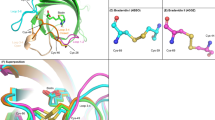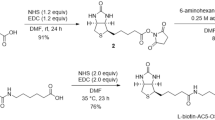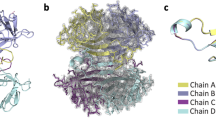Abstract
Streptavidin and avidin are used ubiquitously because of the remarkable affinity of their biotin binding, but they are tetramers, which disrupts many of their applications. Making either protein monomeric reduces affinity by at least 104-fold because part of the binding site comes from a neighboring subunit. Here we engineered a streptavidin tetramer with only one functional biotin binding subunit that retained the affinity, off rate and thermostability of wild-type streptavidin. In denaturant, we mixed a streptavidin variant containing three mutations that block biotin binding with wild-type streptavidin in a 3:1 ratio. Then we generated monovalent streptavidin by refolding and nickel-affinity purification. Similarly, we purified defined tetramers with two or three biotin binding subunits. Labeling of site-specifically biotinylated neuroligin-1 with monovalent streptavidin allowed stable neuroligin-1 tracking without cross-linking, whereas wild-type streptavidin aggregated neuroligin-1 and disrupted presynaptic contacts. Monovalent streptavidin should find general application in biomolecule labeling, single-particle tracking and nanotechnology.
This is a preview of subscription content, access via your institution
Access options
Subscribe to this journal
Receive 12 print issues and online access
$259.00 per year
only $21.58 per issue
Buy this article
- Purchase on Springer Link
- Instant access to full article PDF
Prices may be subject to local taxes which are calculated during checkout




Similar content being viewed by others
References
Green, N.M. Avidin and streptavidin. Methods Enzymol. 184, 51–67 (1990).
Qureshi, M.H. & Wong, S.L. Design, production, and characterization of a monomeric streptavidin and its application for affinity purification of biotinylated proteins. Protein Expr. Purif. 25, 409–415 (2002).
Laitinen, O.H. et al. Rational design of an active avidin monomer. J. Biol. Chem. 278, 4010–4014 (2003).
Green, N.M. & Toms, E.J. The properties of subunits of avidin coupled to sepharose. Biochem. J. 133, 687–700 (1973).
Sano, T. & Cantor, C.R. Intersubunit contacts made by tryptophan 120 with biotin are essential for both strong biotin binding and biotin-induced tighter subunit association of streptavidin. Proc. Natl. Acad. Sci. USA 92, 3180–3184 (1995).
Chilkoti, A., Tan, P.H. & Stayton, P.S. Site-directed mutagenesis studies of the high-affinity streptavidin-biotin complex: contributions of tryptophan residues 79, 108, and 120. Proc. Natl. Acad. Sci. USA 92, 1754–1758 (1995).
Howarth, M., Takao, K., Hayashi, Y. & Ting, A.Y. Targeting quantum dots to surface proteins in living cells with biotin ligase. Proc. Natl. Acad. Sci. USA 102, 7583–7588 (2005).
Klemm, J.D., Schreiber, S.L. & Crabtree, G.R. Dimerization as a regulatory mechanism in signal transduction. Annu. Rev. Immunol. 16, 569–592 (1998).
Klumb, L.A., Chu, V. & Stayton, P.S. Energetic roles of hydrogen bonds at the ureido oxygen binding pocket in the streptavidin-biotin complex. Biochemistry 37, 7657–7663 (1998).
Reznik, G.O., Vajda, S., Sano, T. & Cantor, C.R. A streptavidin mutant with altered ligand-binding specificity. Proc. Natl. Acad. Sci. USA 95, 13525–13530 (1998).
Hyre, D.E., Le, T.I., Freitag, S., Stenkamp, R.E. & Stayton, P.S. Ser45 plays an important role in managing both the equilibrium and transition state energetics of the streptavidin-biotin system. Protein Sci. 9, 878–885 (2000).
Chen, I., Howarth, M., Lin, W. & Ting, A.Y. Site-specific labeling of cell surface proteins with biophysical probes using biotin ligase. Nat. Methods 2, 99–104 (2005).
Scheiffele, P., Fan, J., Choih, J., Fetter, R. & Serafini, T. Neuroligin expressed in nonneuronal cells triggers presynaptic development in contacting axons. Cell 101, 657–669 (2000).
Graf, E.R., Zhang, X., Jin, S.X., Linhoff, M.W. & Craig, A.M. Neurexins induce differentiation of GABA and glutamate postsynaptic specializations via neuroligins. Cell 119, 1013–1026 (2004).
Prange, O., Wong, T.P., Gerrow, K., Wang, Y.T. & El Husseini, A. A balance between excitatory and inhibitory synapses is controlled by PSD-95 and neuroligin. Proc. Natl. Acad. Sci. USA 101, 13915–13920 (2004).
Levinson, J.N. et al. Neuroligins mediate excitatory and inhibitory synapse formation: involvement of PSD-95 and neurexin-1β in neuroligin-induced synaptic specificity. J. Biol. Chem. 280, 17312–17319 (2005).
Chen, I. & Ting, A.Y. Site-specific labeling of proteins with small molecules in live cells. Curr. Opin. Biotechnol. 16, 35–40 (2005).
Johnsson, N., George, N. & Johnsson, K. Protein chemistry on the surface of living cells. ChemBioChem 6, 47–52 (2005).
Miller, L.W. & Cornish, V.W. Selective chemical labeling of proteins in living cells. Curr. Opin. Chem. Biol. 9, 56–61 (2005).
Griffin, B.A., Adams, S.R. & Tsien, R.Y. Specific covalent labeling of recombinant protein molecules inside live cells. Science 281, 269–272 (1998).
Reznik, G.O., Vajda, S., Smith, C.L., Cantor, C.R. & Sano, T. Streptavidins with intersubunit crosslinks have enhanced stability. Nat. Biotechnol. 14, 1007–1011 (1996).
Chilkoti, A., Schwartz, B.L., Smith, R.D., Long, C.J. & Stayton, P.S. Engineered chimeric streptavidin tetramers as novel tools for bioseparations and drug delivery. Bio/Technology 13, 1198–1204 (1995).
Chu, V., Freitag, S., Le, T.I., Stenkamp, R.E. & Stayton, P.S. Thermodynamic and structural consequences of flexible loop deletion by circular permutation in the streptavidin-biotin system. Protein Sci. 7, 848–859 (1998).
Aslan, F.M., Yu, Y., Mohr, S.C. & Cantor, C.R. Engineered single-chain dimeric streptavidins with an unexpected strong preference for biotin-4-fluorescein. Proc. Natl. Acad. Sci. USA 102, 8507–8512 (2005).
Nordlund, H.R. et al. Tetravalent single chain avidin: From subunits to protein domains via circularly permuted avidins. Biochem. J. 392, 485–491 (2005).
Nordlund, H.R., Hytonen, V.P., Laitinen, O.H. & Kulomaa, M.S. Novel avidin-like protein from a root nodule symbiotic bacterium, Bradyrhizobium japonicum. J. Biol. Chem. 280, 13250–13255 (2005).
Niemeyer, C.M. Bioorganic applications of semisynthetic DNA-protein conjugates. Chemistry 7, 3188–3195 (2001).
Wacker, R., Schroder, H. & Niemeyer, C.M. Performance of antibody microarrays fabricated by either DNA-directed immobilization, direct spotting, or streptavidin-biotin attachment: a comparative study. Anal. Biochem. 330, 281–287 (2004).
Keren, K., Berman, R.S., Buchstab, E., Sivan, U. & Braun, E. DNA-templated carbon nanotube field-effect transistor. Science 302, 1380–1382 (2003).
Schmidt, T.G. & Skerra, A. One-step affinity purification of bacterially produced proteins by means of the “Strep tag” and immobilized recombinant core streptavidin. J. Chromatogr. A. 676, 337–345 (1994).
Acknowledgements
Funding was provided by the National Institutes of Health (1 R01 GM072670-01), the EJLB foundation, the Dreyfus foundation, the Sloan foundation and the Massachusetts Institute of Technology. M.H. was supported by a Computational and Systems Biology Initiative MIT–Merck postdoctoral fellowship, D.J.-F.C. by a National Science and Engineering Research Council of Canada postdoctoral fellowship, K.G. by a Michael Smith Foundation for Health Research student fellowship, P.C.D. by a National Institutes of Health Kirschstein NRSA postdoctoral fellowship, N.L.K. by the National Institutes of Health, and A.E.-H. by the Canadian Institutes for Health Research, the Michael Smith Foundation for Health Research, Neuroscience Canada and EJLB foundation. We thank P. Stayton for the streptavidin plasmid, Tanabe USA for biotin, J.A. Ryan for assistance with synthesis and T.S. Chen for preparing AP–neuroligin-1 and Ala–neuroligin-1 constructs.
Author information
Authors and Affiliations
Corresponding author
Ethics declarations
Competing interests
Massachusetts Institute of Technology is seeking to file a patent application covering part of the information contained in this article.
Supplementary information
Supplementary Fig. 1
Mass spectrometry of chimeric streptavidins. (PDF 82 kb)
Supplementary Fig. 2
Labeling of site-specifically biotinylated cell surface proteins with monovalent streptavidin. (PDF 978 kb)
Supplementary Fig. 3
Additional examples of the effect of monovalent and wild-type streptavidin on neuroligin-1 clustering. (PDF 631 kb)
Supplementary Table 1
Neuroligin-1 clustering by streptavidin. (DOC 22 kb)
Supplementary Table 2
Effect of streptavidin on VGLUT1 clustering. (DOC 24 kb)
Rights and permissions
About this article
Cite this article
Howarth, M., Chinnapen, DF., Gerrow, K. et al. A monovalent streptavidin with a single femtomolar biotin binding site. Nat Methods 3, 267–273 (2006). https://doi.org/10.1038/nmeth861
Received:
Accepted:
Published:
Issue Date:
DOI: https://doi.org/10.1038/nmeth861



